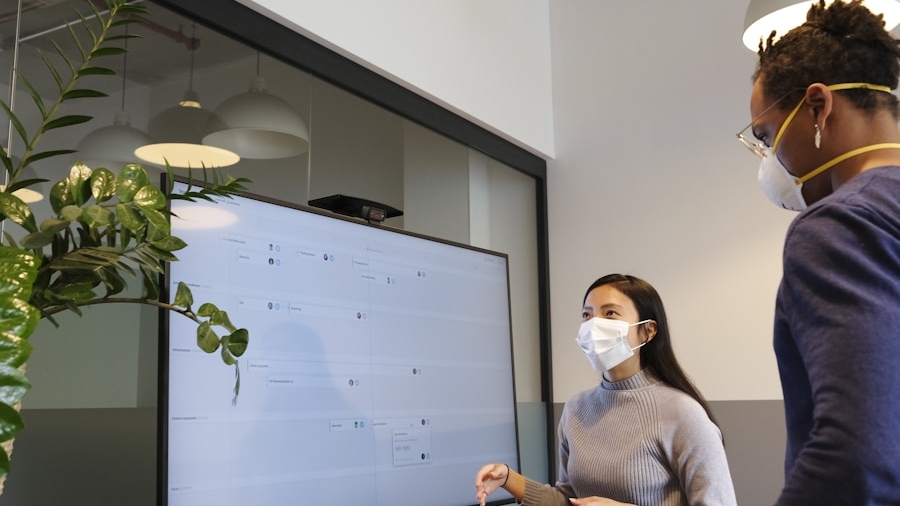The advent of artificial intelligence (AI) has revolutionized numerous sectors, and the realm of virtual workspaces is no exception. AI-powered virtual workspaces integrate advanced technologies to create environments that enhance productivity, streamline communication, and foster collaboration among team members, regardless of their physical locations. These digital ecosystems leverage machine learning, natural language processing, and data analytics to provide users with tools that not only facilitate their daily tasks but also anticipate their needs and preferences.
As organizations increasingly adopt remote work models, the significance of these AI-driven platforms becomes even more pronounced. In essence, AI-powered virtual workspaces serve as a bridge between traditional office settings and the modern demands of a distributed workforce. They offer a suite of applications designed to mimic the collaborative nature of in-person interactions while harnessing the power of technology to overcome geographical barriers.
By automating routine tasks, providing intelligent insights, and enhancing communication channels, these platforms empower teams to work more efficiently and effectively.
Key Takeaways
- AI-powered virtual workspaces are revolutionizing the way teams collaborate and work remotely.
- AI has a significant impact on improving communication, productivity, and efficiency in virtual workspaces.
- Advantages of AI-powered virtual workspaces include personalized user experiences, automation of repetitive tasks, and real-time data analysis.
- Challenges and limitations of AI-powered virtual workspaces include data privacy concerns, potential job displacement, and the need for continuous training and updates.
- AI plays a crucial role in facilitating remote work by enabling seamless communication, project management, and access to resources.
The Impact of AI on Collaboration
AI’s influence on collaboration is profound, reshaping how teams interact and share information.
For instance, AI algorithms can sift through project management data to identify bottlenecks in workflows or predict potential delays based on historical performance metrics.
This capability allows teams to proactively address issues before they escalate, fostering a culture of continuous improvement and responsiveness. Moreover, AI enhances communication within teams by providing real-time language translation and sentiment analysis. Tools like chatbots can facilitate instant communication across different time zones and languages, breaking down barriers that often hinder collaboration in diverse teams.
For example, a multinational team can seamlessly communicate through an AI-powered platform that translates messages in real-time, ensuring that all members are on the same page regardless of their linguistic backgrounds. This level of inclusivity not only improves collaboration but also enriches the team’s collective intelligence by incorporating diverse perspectives.
Advantages of AI-Powered Virtual Workspaces
The advantages of AI-powered virtual workspaces are manifold, significantly impacting productivity and employee satisfaction. One primary benefit is the automation of repetitive tasks, which frees up valuable time for employees to focus on more strategic initiatives. For instance, AI can automate scheduling meetings by analyzing participants’ calendars and suggesting optimal times, thereby eliminating the back-and-forth often associated with finding suitable meeting slots.
This efficiency not only saves time but also reduces frustration among team members. Additionally, AI-powered virtual workspaces provide personalized experiences tailored to individual users’ preferences and work habits. Machine learning algorithms can analyze user behavior to recommend relevant resources, tools, or even colleagues to collaborate with on specific projects.
This level of customization enhances user engagement and ensures that employees have access to the information they need when they need it. For example, an employee working on a marketing campaign might receive suggestions for relevant case studies or templates based on their previous projects, streamlining their workflow and enhancing creativity.
Challenges and Limitations of AI-Powered Virtual Workspaces
Despite the numerous advantages offered by AI-powered virtual workspaces, several challenges and limitations must be addressed for successful implementation. One significant concern is data privacy and security. As organizations increasingly rely on AI systems to manage sensitive information, the risk of data breaches becomes a pressing issue.
Companies must ensure that robust security measures are in place to protect user data from unauthorized access or cyberattacks. This includes implementing encryption protocols, regular security audits, and compliance with data protection regulations such as GDPR. Another challenge lies in the potential for over-reliance on AI technologies.
While automation can enhance efficiency, it may also lead to a decrease in critical thinking and problem-solving skills among employees. If teams become too dependent on AI for decision-making or task execution, they may struggle to adapt when faced with unique challenges that require human intuition and creativity. Organizations must strike a balance between leveraging AI capabilities and fostering an environment that encourages independent thought and innovation among team members.
The Role of AI in Facilitating Remote Work
AI plays a pivotal role in facilitating remote work by providing tools that enhance connectivity and collaboration among distributed teams. Virtual workspaces equipped with AI capabilities enable seamless communication through various channels such as video conferencing, instant messaging, and collaborative document editing. These tools not only replicate the in-person experience but also offer features like screen sharing and real-time feedback, which are essential for effective remote collaboration.
Furthermore, AI can assist in monitoring employee engagement and well-being in remote settings. By analyzing patterns in communication frequency, task completion rates, and even sentiment expressed in messages, organizations can gain insights into employee morale and productivity levels. For instance, if an employee’s communication drops significantly or their tone becomes increasingly negative, managers can intervene proactively to offer support or resources.
This level of attentiveness helps maintain a positive work culture even in a virtual environment.
AI-Powered Virtual Workspaces and Team Productivity
The integration of AI into virtual workspaces has a direct correlation with enhanced team productivity. By automating mundane tasks such as data entry or report generation, employees can allocate more time to high-value activities that require creativity and strategic thinking. For example, an AI system might automatically compile weekly performance reports based on real-time data inputs from various departments, allowing managers to focus on analyzing trends rather than spending hours gathering information.
Moreover, AI-powered analytics tools can provide teams with insights into their performance metrics, enabling them to make data-driven decisions that enhance productivity further. For instance, a sales team might use AI analytics to identify which strategies yield the highest conversion rates or which customer segments are most responsive to their outreach efforts. Armed with this information, teams can refine their approaches and allocate resources more effectively, ultimately driving better results.
The Future of Collaboration with AI-Powered Virtual Workspaces
As technology continues to evolve, the future of collaboration within AI-powered virtual workspaces promises even greater advancements. One potential development is the increased integration of augmented reality (AR) and virtual reality (VR) technologies into these platforms. Imagine a scenario where remote team members can don VR headsets to participate in immersive brainstorming sessions or project reviews as if they were physically present in the same room.
Such innovations could redefine how teams collaborate by creating more engaging and interactive experiences. Additionally, as AI algorithms become more sophisticated, we can expect even greater personalization within virtual workspaces. Future platforms may be able to predict user needs with remarkable accuracy based on historical data and behavioral patterns.
For instance, an AI system could anticipate when a team member is likely to need assistance with a project based on their workload and previous interactions with colleagues. This proactive support could significantly enhance collaboration by ensuring that help is readily available when needed.
Best Practices for Implementing AI-Powered Virtual Workspaces
To maximize the benefits of AI-powered virtual workspaces, organizations should adhere to several best practices during implementation. First and foremost, it is crucial to involve employees in the selection process of these tools. By soliciting feedback from team members regarding their needs and preferences, organizations can choose solutions that align with their workflows and enhance user adoption rates.
Training is another critical component of successful implementation. Employees must be equipped with the knowledge and skills necessary to leverage AI tools effectively. Organizations should invest in comprehensive training programs that cover not only how to use the technology but also best practices for collaboration within virtual environments.
This investment will empower employees to utilize the full potential of AI-powered platforms while fostering a culture of continuous learning. Furthermore, organizations should prioritize data security from the outset by implementing robust security protocols and ensuring compliance with relevant regulations. Regular audits and updates will help maintain a secure environment for sensitive information while building trust among employees regarding data privacy.
In conclusion, as organizations navigate the complexities of modern work environments, embracing AI-powered virtual workspaces presents an opportunity to enhance collaboration, productivity, and employee satisfaction. By understanding both the advantages and challenges associated with these technologies, companies can strategically implement solutions that drive success in an increasingly digital world.
A related article discussing the top 10 best astrology software for PC and Mac in 2023 can be found here. This article explores how AI-powered virtual workspaces are reshaping collaboration, much like how astrology software can provide insights and guidance for individuals. Both technologies aim to enhance productivity and decision-making in different aspects of life.
FAQs
What are AI-powered virtual workspaces?
AI-powered virtual workspaces are digital environments that use artificial intelligence to enhance collaboration and productivity for remote and distributed teams. These platforms integrate AI capabilities to automate tasks, provide personalized recommendations, and facilitate seamless communication and information sharing.
How do AI-powered virtual workspaces reshape collaboration?
AI-powered virtual workspaces reshape collaboration by offering intelligent features such as automated scheduling, real-time language translation, content curation, and predictive analytics. These capabilities streamline workflows, improve decision-making, and foster a more efficient and effective collaboration among team members.
What are the benefits of using AI-powered virtual workspaces?
The benefits of using AI-powered virtual workspaces include improved productivity, enhanced communication, reduced administrative burden, personalized user experiences, and access to valuable insights and analytics. These platforms also enable organizations to adapt to remote work and changing business needs more effectively.
How do AI-powered virtual workspaces impact remote and distributed teams?
AI-powered virtual workspaces empower remote and distributed teams by providing them with the tools and capabilities to collaborate seamlessly, regardless of their physical location. These platforms help bridge the gap between team members, facilitate knowledge sharing, and create a more cohesive and connected work environment.



